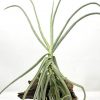hello@airplantplanet.com
Description
Native distribution and habitat: T. duratii is native to Argentina, Brazil, Uruguay,
Bolivia where it is found growing saxicolous on rocks, and as an epiphyte on
trees and shrubs thriving in both sun and shade at altitudes from 200 to 3,500
m. Although a caulescent from the leaves fold backwards and often curl at the
ends.
Growth habit: The plant does not really produce roots but uses its curiously
curved and twisted stems while the heavily lepidote (scruffy scaled leafed) coated
curved leaves twist around trees and rocks to anchor the plant to the host. As
new leaves from the older leaves bend downward to create a skirt like form.
Foliage: The leaves are a curios shape; with a thick cross-section they are long
silver with trichomes and sometimes curved at the end. T. duratii and T. streptocarpa
can look similar till bloom-time.
Flowers: As the flower scape and inflorescence forms it is green but it gradually
turns to a wheat-colour and at this point it can seem that it has somehow
died. Don’t cut it off as it will produce lavender petaled flowers which are highly
fragrant. When fully formed the stalk is about 300 – 400 mm and emerges from
the center of the plant but rather than sitting erect the spike is pushed aside by
further growth of further leaves. The flowers are keeled.
Pups: New pups push out at the top of the plant beside the flower spike.
Cultivation: It is a versatile plant that is able to withstand both rain and drought.
It is considered a very hardy species, and Dr. Mark Dimmitt, reports that for him,
it is the only species that will grow outside all year in Tucson. Dale W. Jenkins of
the Sarasota Bromeliad Society suggests the species is hardy with survival and
little or no damage at -3 ° c for several hours. 1.
Availability: A very sought after plant and not always available.
Size: Approx 8 inch



